|
Friday, Dec. 13
- Breakfast: French bistro breakfast
- Breakfast: chorizo and egg burrito
- Beer-battered fish sandwich
- Teriyaki pork stir fry
- Vegetarian eggplant lasagna
- Cuban panino
- Breakfast-for-lunch omelet bar
- Tomato basil bisque
- Texas-style chili
Wilson Hall Cafe menu
|
|
Saturday, Dec. 14
Dinner
Guest chef: Grace Leonard
- Assortment of small plates, tapas style
Wednesday, Dec. 18
Lunch
- Salmon Wellington
- Parmesan orzo
- Lemon berry Napoleon
Chez Leon menu
Call x3524 to make your reservation.
|
|
Introducing PIP-II
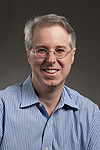 |
|
Stuart Henderson
|
On Thursday the laboratory presented to our staff and users its plan for providing megawatt proton beams to the neutrino program at Fermilab. We will present this plan formally to the P5 advisory panel in the meeting at Brookhaven National Laboratory on Monday.
Over the last two months, the accelerator sector has worked diligently to develop and document a cost-effective concept, named Proton Improvement Plan-II, or PIP-II, that will make Fermilab the best in the world for accelerator-based neutrino experiments. At the same time, PIP-II will provide a platform for longer-term development of the accelerator complex to allow us to retain a world-leading particle physics program for many decades.
The central element of PIP-II is the construction of an 800-MeV superconducting linac injecting into the existing Booster. The higher injection energy will allow us to deliver 50 percent more beam intensity from the Booster and, when paired with modest improvements in the Recycler and Main Injector, will allow us to break the 1-MW barrier in beam power delivered to the Long-Baseline Neutrino Experiment. The plan is to have this capability in place at the time of initiation of LBNE operations.
The PIP-II concept is a descendant of the Project X reference design, with changes that significantly reduce the cost by aligning its capabilities more closely with the LBNE mission. The concept capitalizes directly on expertise in superconducting radio-frequency technologies developed at Fermilab over the last decade. It also significantly reuses existing Tevatron infrastructure, most notably the Central Helium Liquefier. By replacing our aging linac, PIP-II will provide a reliable source of protons at Fermilab for decades to come.
PIP-II is expected to be very attractive to international partners, including our Indian collaborators as well as several institutions in Europe and Asia.
We are all excited about the prospects for PIP-II and look forward to moving ahead following a positive recommendation from P5.
|
PXIE produces first beam
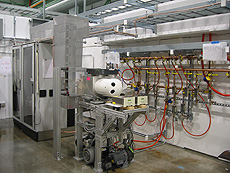 |
The PXIE ion source produced first beam in November. The source is installed inside the aluminum box, visible in the photo, and its beam is measured by a Faraday cup covered by the plastic shield. Photo: Jerry Leibfritz, AD |
The particle source for the PXIE accelerator program produced its first beam at Fermilab on Nov. 26. This begins a new phase for PXIE, one in which scientists will conduct R&D with the negative hydrogen ion beam.
Generation of first beam also marks a major milestone in the completion of the PXIE infrastructure. The PXIE ion source assembly was installed in September, and construction of the PXIE accelerator continues at the Cryomodule Test Facility building inside of a 150-foot-long concrete shielding cave.
In the PXIE program, a test accelerator will replicate the front end of a future high-intensity proton accelerator. The front end is the accelerator's most complex subsystem, comprising novel components with parameters that have not been demonstrated anywhere in the world.
Researchers at Argonne, Berkeley, Oak Ridge and SLAC national laboratories, as well as collaborators in India, participate in PXIE, contributing R&D and major components.
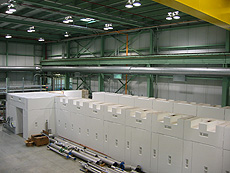 |
This 150-foot-long cave at the Cryomodule Test Facility houses the PXIE injector. Photo: Jerry Leibfritz, AD |
|
Vote for your favorite chairs
Stop by the first floor of Wilson Hall between now and Dec. 20 to test new cafeteria seating options.
Two stools and two chairs are set up at the southeast corner of the cafeteria. Please indicate your favorite of each on the clipboard that is located in the test area.
New furniture is planned to be in place by spring. Thanks in advance for your input.
|
Simulations back up theory that universe is a hologram
From Nature, Dec. 10, 2013
A team of physicists has provided some of the clearest evidence yet that our universe could be just one big projection.
In 1997, theoretical physicist Juan Maldacena proposed that an audacious model of the universe in which gravity arises from infinitesimally thin, vibrating strings could be reinterpreted in terms of well-established physics. The mathematically intricate world of strings, which exist in nine dimensions of space plus one of time, would be merely a hologram: the real action would play out in a simpler, flatter cosmos where there is no gravity.
Read more
|
Synopsis: particle masses don't budge
From Physics, Dec. 4, 2013
Particle masses may not be eternally fixed. The proton, for example, could be gaining or losing weight relative to the electron. However, a change in these masses would alter the absorption spectra of the molecule methanol. As reported in Physical Review Letters, researchers have combined observations of methanol in a distant galaxy to place a robust constraint on variations in the proton-to-electron mass ratio over a time period of half the age of the universe.
Read more
|
|
Turning a page
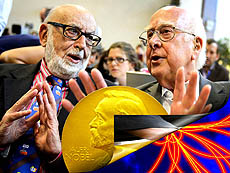 |
The recent discovery of the Higgs boson is without a doubt a big scientific accomplishment, but, for some scientists, it's time to turn the page and use the Higgs boson to search for exciting, new phenomena.
|
Just three days ago, the Swedish Academy of Science held its annual award ceremony for the 2013 Nobel prizes. Francois Englert and Peter Higgs shared the physics prize for the prediction of the Higgs boson. This was a justly deserved recognition of an insight that took nearly half a century to verify. It really was a very big deal.
And yet that was then, and this is now.
The Higgs boson is now following the path of other Nobel Prize-winning discoveries such as those of the charm quark and the W and Z bosons. While the very observation of these particles prompted the popping of champagne bottles, scientists now put these particles to use as part of a checklist to identify particle collisions that are interesting for other reasons. One example involves the 1995 discovery of the top quark. Since top quarks decay into W bosons, scientists searched for events producing W bosons, not to search for the bosons themselves, but as a way to find the top quark.
Today's analysis is similar. CMS scientists searched for events in which a top quark and a Higgs boson were produced. These scientists were interested not in these two particles themselves but rather in a possible new particle called the "vector-like T quark." This particle might not even exist, but it was proposed to explain why the mass of the Higgs boson is as low as it is. From their understanding of the Standard Model, physicists would expect the Higgs boson to be some hundred quadrillion times more massive than it is.
No evidence for the existence of the vector-like T quark was observed, and this allowed CMS scientists to set the most stringent limits on the production and mass of this hypothetical particle. This search included other possible decay channels for the vector-like T quark, but it is the first published result that uses the Higgs boson as a way to identify events that are possibly even more interesting than the Higgs boson itself.
The march of science continues, and the time to savor victory is fleeting. Time waits for no man.
—Don Lincoln
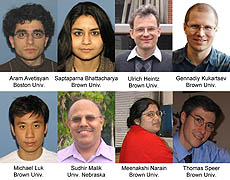 |
These US CMS scientists contributed to this analysis.
|
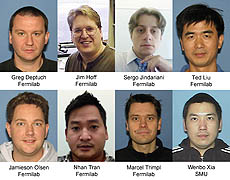 |
This group of U.S. physicists and engineers are working on the next generation of fast pattern-recognition associative-memory ASIC devices for the CMS tracking trigger at the high-luminosity LHC.
|
|
Mingling with Nobel Prize winners in Stockholm
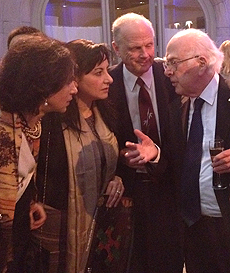 |
| Nobel Prize winner Peter Higgs tells a story to rapt listeners at the Dec. 9 Nobel Prize ceremony reception in Stockholm, Sweden. From left: ATLAS Spokesperson Fabiola Gianotti, Fermilab and University of Chicago scientist Marcela Carena, Physics Nobel Prize Committee Chair Lars Brink, Peter Higgs. Photo courtesy of Marcela Carena, PPD and University of Chicago, and Carlos Wagner, Argonne and University of Chicago |
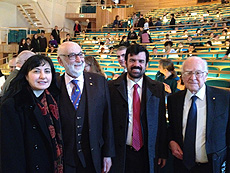 |
| Fermilab and University of Chicago scientist Marcela Carena and Argonne and University of Chicago scientist Carlos Wagner, 1st and 3rd from the left, rub elbows with physics Nobel Prize winners Francois Englert and Peter Higgs at the Dec. 8 Nobel Lectures. Photo courtesy of Marcela Carena, PPD and University of Chicago, and Carlos Wagner, Argonne and University of Chicago |
|
|